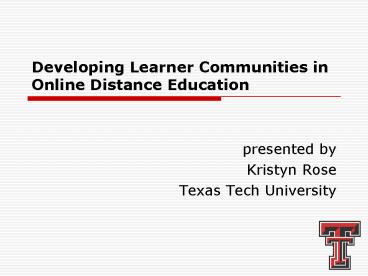Developing Learner Communities in Online Distance Education - PowerPoint PPT Presentation
1 / 24
Title:
Developing Learner Communities in Online Distance Education
Description:
Tools: Email, discussion boards, chat rooms, and instant messages ... Message board discussions. Stand-alone activities with technology. Collaborative projects ... – PowerPoint PPT presentation
Number of Views:272
Avg rating:3.0/5.0
Title: Developing Learner Communities in Online Distance Education
1
Developing Learner Communities in Online Distance
Education
- presented by
- Kristyn Rose
- Texas Tech University
2
Why are we concerned with learner communities?
- Since learners are now engaged with the computer
instead of other learners, they lack a natural
social outlet which can lead to feelings of
isolation. Because isolation is a major
contributor to attrition, one potential strategy
for reducing dropout rates is encouraging the
students to support each other and feel part of a
community. - From Building community in an online learning
environment communication, cooperation and
collaboration Misanchuk and Anderson, 2001
3
Why are we concerned with learner communities?
(continued)
- Learning is described as an interactive group
process in which learners actively construct
knowledge and then build upon that knowledge
through the exchange of ideas with others. - from Examining Social Presence in Online Courses
in Relation to Students Perceived Learning and
Satisfaction, Richardson and Swann, 2003
4
Why are we concerned with learner communities?
(continued)
- The online environment offers the opportunity
for students to share with others their thinking,
interpretation, and reactions to the ideas that
are being presented. For distance education
students, in particular, this is a rich learning
environment when compared with the isolation they
traditionally experienced. - Implementing Computer Mediated Communication in
an Undergraduate Course A Practical Experience
Graham, Scarborough, and Goodwin, 1999
5
Table of Topics
- Survey
- Demographics
- Communication Tools
- Interpersonal Connections
- Sense of Community
- Elements of Community
- Opportunities
- Challenges
- Instructional Design
6
Texas Tech Survey
- Sent to students in online classes
- Education and Instructional Technology (EDIT)
program - Graduate students
- Online survey (SurveyMonkey.com)
- Link sent directly or through instructors
7
Survey Demographics
8
Survey Demographics (continued)
9
Survey Communication Tools
10
Survey Communication Tools (continued)
11
Survey Interpersonal Connections
12
Survey Interpersonal Connections (continued)
13
Survey Sense of Community
14
Survey Sense of Community (continued)
15
Survey Sense of Community (continued)
16
Survey
- Questions or Comments?
17
Elements of Community
- Group identity
- Social interaction
- Individual identity
- Participation
- Ownership
- Integration of all of the above characteristics
- Future orientation
18
Opportunities for Course Design
- Asynchronous
- Tools Email and discussion boards
- Synchronous
- Tools Email, discussion boards, chat rooms, and
instant messages - Collaborative assignments
19
Challenges for Course Design
- Cheating
- Asynchronous
- Synchronous
- Asynchronous course design
- Students work at varying paces
- Synchronous course design
- Technology
20
Instructional Design
- Steps to include
- Clearly define the purpose
- Create a distinctive gathering place
- Encourage effective leadership
- Define norms and a code of conduct
- Allow for a range of member roles
- Facilitate subgroups
- Allow members to resolve disputes
21
Suggestions for Course Design
- Netiquette and proper conduct
- Instructor should be present
- Introductions
- Message board discussions
- Stand-alone activities with technology
- Collaborative projects
- Simulation activities
22
Weve talked about
- Problem of isolation
- Survey
- Important elements
- Opportunities and challenges
- Instructional design
23
Conclusion
- Students make it happen
- The measure of success
24
Questions?
- Contact info
- Kristyn Rose
- Texas Tech University, Extended Studies
- kristyn.rose_at_ttu.edu
- 806-742-7202 ext. 265































